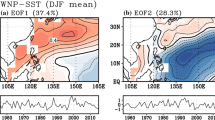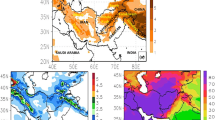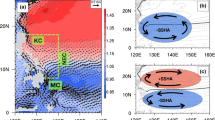Abstract
Evidence show that the dominant mode of winter–spring precipitation anomaly over the tropical Pacific experienced a pronounced interdecadal change around 1998. Based on the extended empirical orthogonal function (EEOF) technique, a zonal dipole pattern of precipitation anomaly is dominant during the pre-1998 period. Corresponding to a positive principle component (PC1), positive precipitation anomaly over the equatorial eastern Pacific (EP) decays eastward from winter to spring, which is identified as an eastward-decaying EP mode. During the post-1999 period, there is a zonal triple pattern with enhanced precipitation over the equatorial central Pacific (CP) and reduced precipitation over the western North Pacific and equatorial southeastern Pacific with a positive PC1. This triple pattern of precipitation anomaly maintains with decreasing amplitude from winter to spring, which is called the fixedly-decaying CP mode for short. Such interdecadal shift is controlled by differing sea surface temperature (SST) anomaly pattern. The interdecadal differences of winter–spring wind stress and thermocline over tropical Pacific might result in the interdecadal change in the SST anomaly and then precipitation mode, via modulating physical oceanic feedback processes. In addition, the effect of two distinct precipitation modes on the North Pacific teleconnection and North American surface temperature anomaly was strikingly different. Before 1998, the eastward-decaying EP mode might induce a significant tropical Northern Hemisphere (TNH)-like teleconnection only in winter, leading to a north-to-south pattern of North American temperature anomaly, which is greatly limited in spring. After 1999, a northwest-to-southeast response of North American temperature sustains from winter to spring, resulting from the maintenance of the Pacific-North America (PNA)-like pattern, simulated by the fixedly-decaying CP mode.













Similar content being viewed by others
References
Adler RF, Huffman GJ, Chang A et al (2003) The version-2 Global Precipitation Climatology Project (GPCP) monthly precipitation analysis (1979–present). J Hydrometeorol 4:1147–1167. https://doi.org/10.1175/1525-7541(2003)004%3c1147:TVGPCP%3e2.0.CO;2
Ashok K, Behera SK, Rao SA et al (2007) El Niño Modoki and its possible teleconnection. J Geophys Res Ocean 112:1–27. https://doi.org/10.1029/2006JC003798
Back LE, Bretherton CS (2009) On the relationship between SST gradients, boundary layer winds, and convergence over the tropical oceans. J Climate 22:4182–4196. https://doi.org/10.1175/2009JCLI2392.1
Behringer D, Xue Y (2004) Evaluation of the global ocean data assimilation system at NCEP: the Pacific Ocean. In: 8th Symp Integr Obs Assim Syst Atmos Ocean L Surface, AMS 84th Annu Meet Washingt State Conv Trade Center, Seattle, pp 11–15
Bond NA, Overland JE, Spillane M, Stabeno P (2003) Recent shifts in the state of the North Pacific. Geophys Res Lett 30:2–5. https://doi.org/10.1029/2003GL018597
Cai W, Cowan T (2009) La Niña Modoki impacts Australia autumn rainfall variability. Geophys Res Lett 36:9–12. https://doi.org/10.1029/2009GL037885
Capotondi A, Wittenberg AT, Newman M et al (2015) Understanding enso diversity. Bull Am Meteorol Soc 96:921–938. https://doi.org/10.1175/BAMS-D-13-00117.1
Chang P, Philander SG (1994) A coupled ocean-atmosphere instability of relevance to the seasonal cycle. J Atmos Sci 51:3627–3648
Chavez FP, Ryan J, Lluch-cota SE et al (2003) From anchovies to sardines and back: multidecadal change in the Pacific ocean. Science (80-) 299:217–221. https://doi.org/10.1126/science.1075880
Chen S-C, Trenberth KE (1988) Forced planetary waves in the Northern Hemisphere winter: wave-coupled orographic and thermal forcings. J Atmos Sci 45:682–704. https://doi.org/10.1175/1520-0469(1988)045%3c0682:FPWITN%3e2.0.CO;2
Chu C, Yang XQ, Ren X, Zhou T (2013) Response of Northern Hemisphere storm tracks to Indian-western Pacific Ocean warming in atmospheric general circulation models. Climate Dyn 40:1057–1070. https://doi.org/10.1007/s00382-013-1687-y
Chu C, Yang X-Q, Sun X et al (2017) Effect of the tropical Pacific and Indian Ocean warming since the late 1970s on wintertime Northern Hemispheric atmospheric circulation and East Asian climate interdecadal changes. Climate Dyn 22:1–18
Dee DP, Uppala SM, Simmons AJ et al (2011) The ERA-interim reanalysis: configuration and performance of the data assimilation system. Q J R Meteorol Soc 137:553–597. https://doi.org/10.1002/qj.828
Ding Q, Steig EJ, Battisti DS, Küttel M (2011) Winter warming in West Antarctica caused by central tropical Pacific warming. Nat Geosci 4:398–403. https://doi.org/10.1038/ngeo1129
Ding R, Li J, Tseng Y et al (2016) Interdecadal change in the lagged relationship between the Pacific-South American pattern and ENSO. Climate Dyn 47:2867–2884. https://doi.org/10.1007/s00382-016-3002-1
Dong B, Dai A (2015) The influence of the interdecadal Pacific oscillation on temperature and precipitation over the globe. Climate Dyn 45:2667–2681. https://doi.org/10.1007/s00382-015-2500-x
Feng J, Li J (2011) Influence of El Niño Modoki on spring rainfall over south China. J Geophys Res Atmos 116:1–10. https://doi.org/10.1029/2010JD015160
Garfinkel CI, Waugh DW, Oman LD et al (2013) Temperature trends in the tropical upper troposphere and lower stratosphere: connections with sea surface temperatures and implications for water vapor and ozone. J Geophys Res Atmos 118:9658–9672. https://doi.org/10.1002/jgrd.50772
Guo Y, Wen Z, Wu R et al (2015) Impact of tropical Pacific precipitation anomaly on the East Asian upper-tropospheric westerly jet during the boreal winter. J Climate 28:6457–6474. https://doi.org/10.1175/JCLI-D-14-00674.1
Guo Y, Wen Z, Wu R (2016) Interdecadal change in the tropical Pacific precipitation anomaly pattern around the late 1990s during boreal spring. J Climate 29:5979–5997. https://doi.org/10.1175/JCLI-D-15-0462.1
Guo Y, Ting M, Wen Z, Lee DE (2017) Distinct patterns of tropical Pacific SST anomaly and their impacts on North American climate. J Climate 30:5221–5241. https://doi.org/10.1175/JCLI-D-16-0488.1
Guo Y, Wen Z, Chen R et al (2019) Effect of boreal spring precipitation anomaly pattern change in the late 1990s over tropical Pacific on the atmospheric teleconnection. Climate Dyn 52:401–416. https://doi.org/10.1007/s00382-018-4149-8
Harris I, Jones PD, Osborn TJ, Lister DH (2014) Updated high-resolution grids of monthly climatic observations—the CRU TS3.10 dataset. Int J Climatol 34:623–642. https://doi.org/10.1002/joc.3711
Holton JR, Wallace JM, Young JA (1971) On boundary layer dynamics and the ITCZ. J Atmos Sci 28:275–280. https://doi.org/10.1175/1520-0469(1971)028%3c0275:obldat%3e2.0.co;2
Horel JD, Wallace JM (1981) Planetary-scale phenomena associated with the Southern Oscillation. Mon Weather Rev 109:813–829
Hoskins BJ, Karoly DJ (1981) The steady linear response of a spherical atmosphere to thermal and orographic forcing. J Atmos Sci 38:1179–1196
Hu ZZ, Kumar A, Ren H-L et al (2013) Weakened interannual variability in the tropical Pacific ocean since 2000. J Climate 26:2601–2613. https://doi.org/10.1175/JCLI-D-12-00265.1
Hu ZZ, Kumar A, Huang B et al (2017) Interdecadal variations of ENSO around 1999/2000. J Meteorol Res 31:73–81. https://doi.org/10.1007/s13351-017-6074-x
Infanti JM, Kirtman BP (2016) North American rainfall and temperature prediction response to the diversity of ENSO. Climate Dyn 46:3007–3023. https://doi.org/10.1007/s00382-015-2749-0
Jia XJ, Wang S, Lin H, Bao Q (2015) A connection between the tropical Pacific Ocean and the winter climate in the Asian-Pacific region. J Geophys Res 120:430–448. https://doi.org/10.1002/2014JD022324
Jin F, An S (1999) Thermocline and zonal advective feedbacks within the equatorial ocean recharge oscillator model for ENSO. Geophys Res Lett 26:2989–2992. https://doi.org/10.1029/1999gl002297
Jin FF, Kim ST, Bejarano L (2006) A coupled-stability index for ENSO. Geophys Res Lett 33:2–5. https://doi.org/10.1029/2006GL027221
Jo H-S, Yeh S-W, Lee S-K (2015) Changes in the relationship in the SST variability between the tropical Pacific and the North Pacific across the 1998/99 regime shift. Geophys Res Lett 42:7171–7178. https://doi.org/10.1002/2015GL065049
Kao HY, Yu JY (2009) Contrasting Eastern-Pacific and Central-Pacific types of ENSO. J Climate 22:615–632. https://doi.org/10.1175/2008JCLI2309.1
Lee S, Gong T, Johnson N et al (2011) On the possible link between tropical convection and the Northern Hemisphere Arctic surface air temperature change between 1958–2001. J Climate. https://doi.org/10.1175/2011JCLI4003.1
Lindzen RS, Nigam S (1987) On the role of sea surface temperature gradients in forcing low-level winds and convergence in the tropics. J Atmos Sci 44:2418–2436. https://doi.org/10.1175/1520-0469(1987)044%3c2418:OTROSS%3e2.0.CO;2
Luyten JR (1983) The ventilated thermocline. J Phys Oceanogr 13:292–309. https://doi.org/10.1175/1520-0485(1983)013%3c0292:TVT%3e2.0.CO;2
Lyon B, Dewitt DG (2012) A recent and abrupt decline in the East African long rains. Geophys Res Lett 39:1–5. https://doi.org/10.1029/2011GL050337
Lyon B, Barnston AG, DeWitt DG (2014) Tropical pacific forcing of a 1998–1999 climate shift: observational analysis and climate model results for the boreal spring season. Climate Dyn 43:893–909. https://doi.org/10.1007/s00382-013-1891-9
McBride JL, Haylock MR, Nicholls N (2003) Relationships between the maritime continent heat source and the El Niño-Southern oscillation phenomenon. J Climate 16:2905–2914. https://doi.org/10.1175/1520-0442(2003)016%3c2905:RBTMCH%3e2.0.CO;2
McPhaden MJ (2012) A 21st century shift in the relationship between ENSO SST and warm water volume anomalies. Geophys Res Lett 39:1–5. https://doi.org/10.1029/2012GL051826
Mo KC (2010) Interdecadal modulation of the impact of ENSO on precipitation and temperature over the United States. J Climate 23:3639–3656. https://doi.org/10.1175/2010JCLI3553.1
Mo KC, Livezey RE (1986) Tropical-extratropical geopotential height teleconnections during the Northern Hemisphere Winter. Mon Weather Rev 114:2488–2515
Park J-H, An S-I (2014) The impact of tropical western Pacific convection on the North Pacific atmospheric circulation during the boreal winter. Climate Dyn 43:2227–2238. https://doi.org/10.1007/s00382-013-2047-7
Peterson WT, Schwing FB (2003) A new climate regime in northeast pacific ecosystems. Geophys Res Lett 30:1–4. https://doi.org/10.1029/2003GL017528
Philander SGH, Yoon J-H (1982) Eastern boundary currents and coastal upwelling. J Phys Oceanogr 12:862–879
Praveen Kumar B, Vialard J, Lengaigne M et al (2013) TropFlux wind stresses over the tropical oceans: evaluation and comparison with other products. Climate Dyn 40:2049–2071. https://doi.org/10.1007/s00382-012-1455-4
Rasmusson EM, Carpenter TH (1982) Variations in tropical sea surface temperature and surface wind fields associated with the southern oscillation/El Niño. Mon Weather Rev 110:354–384. https://doi.org/10.1175/1520-0493(1982)110%3c0354:VITSST%3e2.0.CO;2
Rayner NA, Parker DE, Horton EB et al (2003) Global analyses of sea surface temperature, sea ice, and night marine air temperature since the late nineteenth century. J Geophys Res 108:4407. https://doi.org/10.1029/2002JD002670
Sobel AH, Neelin JD (2006) The boundary layer contribution to intertropical convergence zones in the quasi-equilibrium tropical circulation model framework. Theor Comput Fluid Dyn 20:323–350. https://doi.org/10.1007/s00162-006-0033-y
Su J, Zhang R, Li T et al (2010) Causes of the El Niño and La Niñ a amplitude asymmetry in the Equatorial Eastern Pacific. J Climate 23:605–617. https://doi.org/10.1175/2009JCLI2894.1
Taschetto AS, England MH (2009) El Niño Modoki impacts on Australian rainfall. J Climate 22:3167–3174. https://doi.org/10.1175/2008JCLI2589.1
Taschetto AS, Haarsma RJ, Sen Gupta A et al (2010) Australian monsoon variability driven by a Gill-Matsuno-type response to central west Pacific warming. J Climate 23:4717–4736. https://doi.org/10.1175/2010JCLI3474.1
Wallace JM, Gutzler DS (1981) Teleconnections in the geopotential height field during the Northern Hemisphere winter. Mon Weather Rev 109:784–812
Wang B, Zhang Q (2002) Pacific-East Asian teleconnection. Part II: how the Philippine Sea anomalous anticyclone is established during El Niño development. J Climate 15:3252–3265. https://doi.org/10.1175/1520-0442(2002)015%3c3252:PEATPI%3e2.0.CO;2
Wang B, Wu R, Fu X (2000) Pacific-East Asian teleconnection: how does ENSO affect East Asian climate? J Climate 13:1517–1536
Wang B, Wu R, Li T (2003) Atmosphere-warm ocean interaction and its impacts on Asian-Australian monsoon variation. J Climate 16:1195–1211. https://doi.org/10.1175/1520-0442(2003)16%3c1195:AOIAII%3e2.0.CO;2
Wang C, Deser C, Yu J (2017) El Niño and Southern Oscillation (ENSO): a review. Coral reefs of the Eastern Tropical Pacific. Springer, Dordrecht, pp 3–19
Webster PJ (1982) Seasonality in the local and remote atmospheric response to sea surface temperature anomalies. J Atmos Sci 39:41–52. https://doi.org/10.1175/1520-0469(1982)039%3c0041:SITLAR%3e2.0.CO;2
Weng H, Behera SK, Yamagata T (2009) Anomalous winter climate conditions in the Pacific rim during recent El Niño Modoki and El Niño events. Climate Dyn 32:663–674. https://doi.org/10.1007/s00382-008-0394-6
Wu B, Zhou T, Li T et al (2012) Two distinct modes of tropical Indian ocean precipitation in boreal winter and their impacts on Equatorial Western Pacific. J Climate 25:921–938. https://doi.org/10.1175/JCLI-D-11-00065.1
Xiang B, Wang B, Li T (2013) A new paradigm for the predominance of standing Central Pacific Warming after the late 1990s. Climate Dyn 41:327–340. https://doi.org/10.1007/s00382-012-1427-8
Xie P, Arkin PA (1997) Global precipitation: a 17-year monthly analysis based on gauge observations, satellite estimates, and numerical model outputs. Bull Am Meteorol Soc 78:2539–2558. https://doi.org/10.1175/1520-0477(1997)078%3c2539:GPAYMA%3e2.0.CO;2
Xu C, Qiao Y (2018) The interdecadal change in the intensity of interannual variation of spring precipitation over southern China and its relationship with the SST anomaly. J Meteorol Sci 38:281–292
Yu JY, Zou Y, Kim ST, Lee T (2012) The changing impact of El Nio on US winter temperatures. Geophys Res Lett. https://doi.org/10.1029/2012GL052483
Yu B, Zhang XL, Lin H, Yu J (2015) Comparison of wintertime North American climate impacts associated with multiple ENSO indices. Atmos Ocean 53(4):426–445. https://doi.org/10.1016/j.cognition.2008.05.007
Zhang X, Mcphaden MJ (2006) Wind stress variations and interannual sea surface temperature anomalies in the Eastern Equatorial Pacific. J Climate 19:226–241. https://doi.org/10.1175/JCLI3618.1
Zheng J, Liu Q, Wang C, Zheng XT (2013) Impact of heating anomalies associated with rainfall variations over the Indo-Western Pacific on Asian atmospheric circulation in winter. Climate Dyn 40:2023–2033. https://doi.org/10.1007/s00382-012-1478-x
Acknowledgements
We appreciate the constructive suggestions and comments from two anonymous reviewers, which helped to improve the paper. This research was jointly supported by National Key Research and Development Program of China (2016YFA0600601) and National Natural Science Foundation of China (41530530, 41875087 and 41775043).
Author information
Authors and Affiliations
Corresponding author
Additional information
Publisher's Note
Springer Nature remains neutral with regard to jurisdictional claims in published maps and institutional affiliations.
Rights and permissions
About this article
Cite this article
Guo, Y., Wen, Z. & Li, X. Interdecadal change in the principal mode of winter–spring precipitation anomaly over tropical Pacific around the late 1990s. Clim Dyn 54, 1023–1042 (2020). https://doi.org/10.1007/s00382-019-05042-2
Received:
Accepted:
Published:
Issue Date:
DOI: https://doi.org/10.1007/s00382-019-05042-2




